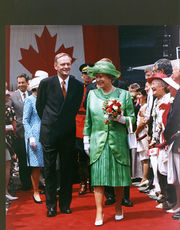Canada Day
| Canada Day | |
|---|---|
Children watch the Canada Day parade in Montreal |
|
| Also called | Fête du Canada; previously named Dominion Day |
| Observed by | Canadians (Canada) |
| Type | Historical, cultural, nationalist |
| Date | July 1 |
| Celebrations | Fireworks, parades, barbecues, concerts, carnivals, fairs, picnics |
Canada Day (French: Fête du Canada), formerly Dominion Day (French: Le Jour de la Confédération), is Canada's national day, a federal statutory holiday celebrating the anniversary of the July 1, 1867, enactment of the British North America Act (today called the Constitution Act, 1867), which united two British colonies and a province of the British Empire into a single country, still within the Empire, called Canada.[1][2][3] Canada Day observances take place throughout Canada as well as internationally.
Contents |
Commemoration
Frequently referred to as "Canada's birthday", particularly in the popular press,[4][5][6] the occasion marks the joining of the British North American colonies of Nova Scotia, New Brunswick, and the Province of Canada into a federation of four provinces (the Province of Canada being divided, in the process, into Ontario and Quebec) on July 1, 1867. Canada became a kingdom in its own right on that date,[n 1][8][9][10][11] but the British Parliament kept limited rights of political control over the new country that were shed by stages over the years until the last vestiges were surrendered in 1982 when the Constitution Act patriated the Canadian constitution.[n 2]
Exceptions
Under the federal Holidays Act, Canada Day is observed on July 1 unless that date falls on a Sunday, in which case July 2 is the statutory holiday, although celebratory events generally take place on July 1 even though it is not the legal holiday.[12] If it falls on a Saturday, the following Monday is generally also a day off for those businesses ordinarily closed on Saturdays.
History

On June 20, 1868, Governor General the Viscount Monck issued a royal proclamation asking for Canadians to "celebrate the anniversary of the confederation."[13] However, the holiday was not established statutorily until 1879, when it was designated as Dominion Day, in reference to the designation of the country as a Dominion in the British North America Act. The holiday was initially not dominant in the national calendar; up to the early 20th century, Canadians thought themselves to be primarily British, being thus less interested in celebrating distinctly Canadian forms of patriotism. No official celebrations were therefore held until 1917 — the golden anniversary of Confederation — and then none again for a further decade.[14]
In 1946, Philéas Côté, a Quebec member of the House of Commons, introduced a private member's bill to rename Dominion Day as Canada Day.[15] His bill was passed quickly by the House of Commons but was stalled by the Senate, which returned the bill to the Commons with the recommendation that the holiday be renamed The National Holiday of Canada, an amendment that effectively killed the bill.[16]

Beginning in 1958, the Canadian government began to orchestrate Dominion Day celebrations, usually consisting of Trooping the Colour ceremonies on Parliament Hill in the afternoon and evening, followed by a mass band concert and fireworks display. Canada's centennial in 1967 is often seen as an important milestone in the history of Canadian patriotism, and in Canada's maturing as a distinct, independent country, after which Dominion Day became more popular with average Canadians. Into the late 1960s, nationally televised, multi-cultural concerts held in Ottawa were added, and the fête became known as Festival Canada; after 1980 the Canadian government began to promote the celebrating of Dominion Day beyond the national capital, giving grants and aid to cities across the country to help fund local activities.
With only twelve Members of Parliament present, eight less than a quorum,[17] the private member's bill that proposed to change the name to Canada Day was passed in the House of Commons in five minutes, and without debate.[18] With the granting of Royal Assent, the name was officially changed to Canada Day on October 27, 1982, a move largely inspired by the adoption of the Canada Act, earlier in the year. Although the proposal caused some controversy,[18] many Canadians had already been informally referring to the holiday as Canada Day for a number of years before the official name change occurred.[n 3] Andrew Cohen, a former Globe and Mail and current Ottawa Citizen columnist, called Canada Day a term of "crushing banality" and criticized the change from Dominion Day "a renunciation of the past, [and] a misreading of history, laden with political correctness and historical ignorance."[23] For Cohen, the change is an example of systemic denial of Canadian history by the Canadian government.[24]
As the anniversary of Confederation, Dominion Day, and later Canada Day, was the date set for a number of important events, such as the first (temporary) national radio network hookup by the Canadian National Railway (1927), the inauguration of the CBC's cross-country television broadcast (1958), the flooding of the Saint Lawrence Seaway (1958), the first colour television transmission in Canada (1966), the inauguration of the Order of Canada (1967), and the establishment of "O Canada" as the country's national anthem (1980). Other events fell on the same day coincidentally, such as the first day of the Battle of the Somme in 1916 — shortly after which Newfoundland recognized July 1 as Memorial Day to commemorate the Newfoundland Regiment's heavy losses during the battle[25][26] — and the enactment of the Chinese Immigration Act in 1923 — leading Chinese-Canadians to refer to July 1 as Humiliation Day and boycott Dominion Day celebrations, until the act was repealed in 1947.[27]
Activities


Most communities across the country will host organized celebrations for Canada Day, usually outdoor public events, such as parades, carnivals, festivals, barbecues, air and maritime shows, fireworks, and free musical concerts,[28] as well as citizenship ceremonies for new citizens.[29][30] There is no standard mode of celebration for Canada Day; professor of International Relations at the University of Oxford Jennifer Welsh said of this: "Canada Day, like the country, is endlessly decentralized. There doesn't seem to be a central recipe for how to celebrate it — chalk it up to the nature of the federation."[31] However, the locus of the celebrations is the national capital, Ottawa, Ontario, where large concerts, presided over by the governor general, are held on Parliament Hill, as well as other parks around the city and in Hull, Quebec. The sovereign may also be in attendance at Canada Day celebrations in Ottawa; Queen Elizabeth II was present in 1990, 1992, 1997,[32] and 2010.[33] The Queen also helped celebrate Canada's 100th anniversary on July 1, 1967.[14]
Given the federal nature of the holiday, celebrating Canada Day can be a cause of friction in the province of Quebec, where the holiday is overshadowed by Quebec's National Holiday, on June 24.[34] For example, the federal government funds events at the Old Port of Montreal — an area run by a federal Crown corporation — while the parade is a grassroots effort that has been met with pressure to cease, even from federal officials.[35] The nature of the event has also been met with criticism from English Canadians, such as Ottawa Citizen columnist David Warren, who said in 2007: "The Canada of the government-funded paper flag-waving and painted faces — the 'new' Canada that is celebrated each year on what is now called 'Canada Day' — has nothing controversially Canadian about it. You could wave a different flag, and choose another face paint, and nothing would be lost."[36]
Canada Day also coincides with Quebec's traditional Moving Day, when many fixed-lease apartment rental terms expire. The bill changing the province's moving day from May 1 to July 1 was introduced by a federalist member of the Quebec National Assembly, Jérôme Choquette,[37] in order not to affect children still in school in the month of May.[38]
International celebrations

Canadian expatriates will organize Canada Day activities in their local area on or near the date of the holiday. For instance, since 2006, annual Canada Day celebrations have been held at Trafalgar Square — the location of Canada House — in London, England; organized by the Canadian community in the United Kingdom and the Canadian High Commission, the event features Canadian performers and a demonstration of street hockey, amongst other activities.[39] Annual celebrations also take place in Hong Kong, entitled Canada D'eh and held on June 30 at Lan Kwai Fong, where an estimated attendance of 12,000 was reported in 2008; in Afghanistan, where members of the Canadian Forces mark the holiday at their base;[40][41] and in Mexico, at the American Legion in Chapala and the Canadian Club in Ajijic.
Detroit, Michigan, and Windsor, Ontario, have, since the 1950s, celebrated both Dominion or Canada Day and the United States' Independence Day with the International Freedom Festival. A massive fireworks display over the Detroit River, the strait separating the two cities, is held annually with hundreds of thousands of spectators attending. A similar event occurs at the Friendship Festival, a joint celebration between Fort Erie, Ontario, and neighbouring Buffalo, New York, of Canada Day and Independence Day.
See also
- Public holidays in Canada
- National Flag of Canada Day
Notes
- ↑ Canadian representatives had actually requested the title Kingdom of Canada be granted, to "fix the monarchical basis of the constitution," but the idea was vetoed by the British Foreign Secretary at the time, the Lord Stanley, and the title Dominion was used in its place.[7] See Name of Canada > Adoption of Dominion.
- ↑ Among the powers retained by the Crown in its British Council was the power to declare war.
- ↑ Numerous references to the term Canada Day may be found in issues of The Globe and Mail published in the late 1970s.[19][20][21][22]
Footnotes
- ↑ "Canada in the Making > Constitutional History > 1867 - 1931: Becoming a Nation". Canadiana. http://www1.canadiana.org/citm/themes/constitution/constitution13_e.html. Retrieved July 1, 2010.
- ↑ Department of Natural Resources. "Natural Resources Canada > Atlas Home > Explore Our Maps > History > Territorial Evolution > Territorial Evolution, 1867". Queen's Printer for Canada. http://atlas.nrcan.gc.ca/auth/english/maps/historical/territorialevolution/1867/1. Retrieved July 1, 2010.
- ↑ Moore, Christopher (1998). 1867: How the Fathers Made a Deal. Toronto: McClelland & Stewart. pp. 1, 215. ISBN 9780771060960. http://books.google.com/?id=Xumx9T6CrcIC&printsec=frontcover&q.
- ↑ Panetta, Alexander; Pedwell, Terry (July 2, 2007). "An unforgettable Canada Day, eh?". Toronto Star. http://www.thestar.com/article/231568. Retrieved May 12, 2007.
- ↑ "Canada Day celebrations". Toronto Star. June 29, 2007. http://www.thestar.com/article/230791. Retrieved May 12, 2007.
- ↑ Canwest News Service (July 1, 2007). "Harper salutes international role in Canada Day address". National Post. http://www.canada.com/nationalpost/story.html?id=1153724d-9877-48af-9608-adef9a42d9cf. Retrieved May 12, 2007.
- ↑ Colquhoun, A. H. U. (2009). "The Fathers of Confederation: A Chronicle of the Birth of the Dominion". In Wrong, George M.; Langton, H. H.. The Chronicles of Canada. III. Tucson: Fireship Press. p. 60. ISBN 9781934757512. http://books.google.com/?id=Qs6IKxQxUjsC&printsec=frontcover&q. Retrieved July 1, 2010.
- ↑ "Heritage Saint John > Canadian Heraldry". Heritage Resources of Saint John and New Brunswick Community College. http://www.saintjohn.nbcc.nb.ca/~HeritageSaintJohn/CorporateSeal/heraldry.htm. Retrieved July 3, 2009.
- ↑ The Royal Household. "The Queen and the Commonwealth > Queen and Canada > History and present government". Queen's Printer. http://www.royal.gov.uk/MonarchAndCommonwealth/Canada/Historyandpresentgovernment.aspx. Retrieved July 3, 2009.
- ↑ Department of Canadian Heritage (2005). The Crown in Canada. Queen's Printer for Canada. p. 7. http://dsp-psd.pwgsc.gc.ca/Collection/CH4-127-2003E.pdf. Retrieved July 3, 2009.
- ↑ Department of Canadian Heritage. Canada: Symbols of Canada. Queen's Printer for Canada. p. 3. http://www.pch.gc.ca/pgm/ceem-cced/symbl/101/101-eng.pdf. Retrieved July 1, 2010.
- ↑ Government of Saskatchewan (June 18, 2007). "Canada Day to be observed Monday, July 2". Queen's Printer for Saskatchewan. http://www.gov.sk.ca/news?newsId=b3903533-2a8d-40d7-8bc9-d718d9fd9367. Retrieved January 23, 2010.
- ↑ Department of Canadian Heritage. "Ceremonial and Canadian Symbols Promotion > Canada Day". Queen's Printer for Canada. http://www.pch.gc.ca/pgm/ceem-cced/jfa-ha/canada-eng.cfm. Retrieved July 1, 2009.
- ↑ 14.0 14.1 Canadian Heritage. "Canada Day Background/How we got our national holiday". Canoe. http://www.canoe.ca/Canadiana/canday.html. Retrieved July 1, 2009.
- ↑ Carnegie, R.K. (April 19, 1946). "Drew Right: Provinces Have Say-So On Holidays". The Globe and Mail: p. 15.
- ↑ Editorial Board (August 10, 1946). "A New Low in Compromise". The Globe and Mail: p. 6.
- ↑ Marleau, Robert; Montpetit, Camille (January 2000). "9. Sittings of the House". House of Commons Procedure and Practice. Ottawa: Queen's Printer for Canada. http://www2.parl.gc.ca/MarleauMontpetit/DocumentViewer.aspx?Sec=Ch09&Seq=3&Lang=E. Retrieved June 1, 2009.
- ↑ 18.0 18.1 "Society > Celebrations > Celebrating Canada Day". CBC. http://archives.cbc.ca/society/celebrations//topics/2328/. Retrieved July 1, 2009.
- ↑ "Across Canada/Pro-Canada sign painter has brush with law". The Globe and Mail: p. 12. November 19, 1977.
- ↑ Cherry, Zena (February 20, 1978). "Protocol chiefs gather to discuss their trade". The Globe and Mail: p. 27.
- ↑ Stevens, Geoffrey (March 2, 1978). "With many tongues". The Globe and Mail: p. 6.
- ↑ Canadian Press (March 30, 1978). "Federal support for new festival". The Globe and Mail: p. 16.
- ↑ Andrew, Cohen (2007). The Unfinished Canadian. Toronto: McClelland & Stewart. p. 90. ISBN 978-0771022869. http://books.google.com/?id=glcBcaMC6doC&lpg=PP1&dq=Andrew%2C%20Cohen%20(2007).%20The%20Unfinished%20Canadian.&pg=PA90#v=onepage&q=Andrew,%20Cohen%20(2007).%20The%20Unfinished%20Canadian..
- ↑ Cohen 2007, p. 89
- ↑ Hiscock, Philip. "Society and Culture > Folklore and Traditional Culture > Custom". Memorial University of Newfoundland. http://www.heritage.nf.ca/society/custom.html. Retrieved June 18, 2008.
- ↑ "A Living Memorial > Memorial Day". Memorial University of Newfoundland. http://www.mun.ca/memorial/living/memorial_day.php. Retrieved May 31, 2008.
- ↑ "CBC News > Indepth > China > Chinese Immigration". CBC. June 10, 2004. http://www.cbc.ca/news/background/china/chinese_immigration.html. Retrieved July 1, 2009.
- ↑ Department of Canadian Heritage. "British Columbia and Yukon invited to participate to "Celebrate Canada!" Days". Queen's Printer for Canada. http://www.canadianheritage.gc.ca/newsroom/index_e.cfm?fuseaction=displayDocument&DocIDCd=6NR110. Retrieved May 31, 2008.
- ↑ Citizenship and Immigration Canada. "Applying for citizenship > The citizenship ceremony". Queen's Printer for Canada. http://www.cic.gc.ca/English/citizenship/cit-ceremony.asp. Retrieved July 1, 2009.
- ↑ "Canadian Citizenship Oath". Robinson Sheppard Shapiro. http://www.rsscanadaimmigration.com/en/citizenship/citizenshipoath.php. Retrieved July 1, 2009.
- ↑ Allemang, John (June 28, 2008). "We stand on guard for what?". Globe and Mail. http://www.theglobeandmail.com/servlet/story/RTGAM.20080627.wcandayfocusdebate/BNStory/CanadaDay2008/?pageRequested=all. Retrieved July 1, 2009.
- ↑ Bousfield, Arthur; Toffoli, Garry. "Elizabeth II Queen of Canada: The Role of Queen Elizabeth II". Canadian Royal Heritage Trust. http://www.crht.ca/DiscoverMonarchyFiles/QueenElizabethII.html. Retrieved May 31, 2008.
- ↑ Queen's Printer (January 22, 2010). "The Queen to address the United Nations". Press release. http://www.royal.gov.uk/LatestNewsandDiary/Pressreleases/2010/TheQueentoaddresstheUnitedNations.aspx. Retrieved January 23, 2010.
- ↑ Fedio, Chloe (June 17, 2010). "Canada Day Parade organizers bemoan lack of political support". The Gazette. http://www.montrealgazette.com/health/Canada+Parade+organizers+bemoan+lack+political+support/3164763/story.html. Retrieved July 1, 2010.
- ↑ Hustake, Aalan (May 25, 2008). "Proud Canadian, proud Quebecer who loved a parade". The Gazette. http://www.canada.com/montrealgazette/news/insight/story.html?id=069c09a6-3deb-4246-8e2e-a7d5324b8b26. Retrieved May 25, 2008.
- ↑ Warren, David (July 1, 2007). "Sea to sea". Ottawa Citizen. http://www.davidwarrenonline.com/index.php?id=750.
- ↑ Lejtenyi, Patrick. "Moving day conspiracy". Montreal Mirror. http://www.montrealmirror.com/ARCHIVES/2002/070402/ncity.html. Retrieved July 1, 2009.
- ↑ Madigan, Tracey (June 28, 2005). "Get a Move On". CBC. http://www.cbc.ca/montreal/features/movingday/. Retrieved July 1, 2010.
- ↑ The Canadian High Commission in London. "Canada Day in London". Queen's Printer for Canada. http://www.canadadaylondon.com/default.asp. Retrieved July 1 , 2009.
- ↑ Queen's Printer for Canada (June 29, 2006). "Afghanistan Canada Day Celebrations Video Footage Available on Website". Press release. http://www.forces.gc.ca/site/news-nouvelles/view-news-afficher-nouvelles-eng.asp?id=1972. Retrieved July 1, 2009.
- ↑ "Troops refuse to let attack mar Canada Day break". CTV. July 1, 2006. http://www.ctv.ca/servlet/ArticleNews/story/CTVNews/20060629/afghanistan_canadaday_060701/20060701?hub=TopStories. Retrieved August 6, 2009.
External links
- Government of Canada site on Canada Day
- National Capital Commission
- Holidays Act, R.S.C. 1985, c. H-5
- We should be celebrating Dominion Day
- CBC Digital Archives: Celebrating Canada Day
|
|||||||||||
|
|||||||||||||||||||||||||||||||||||||||||||||||||||||||